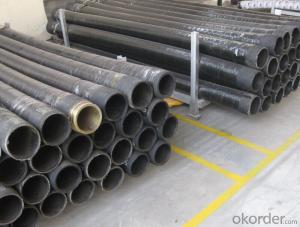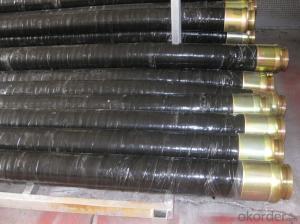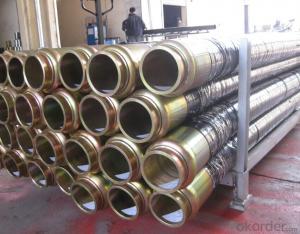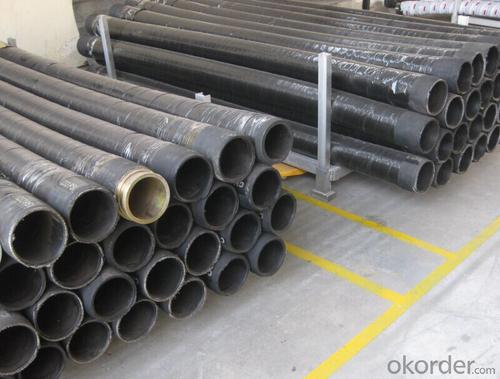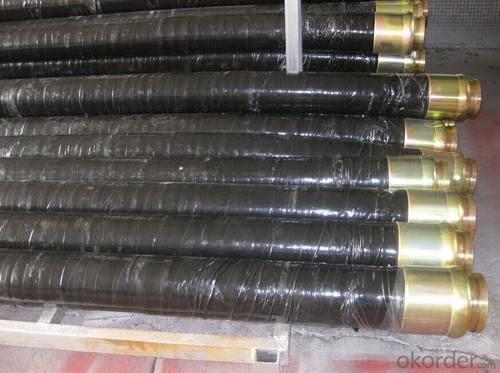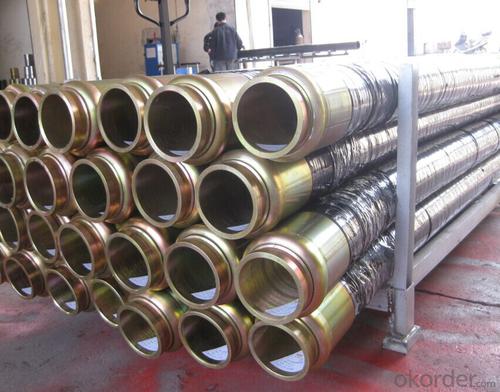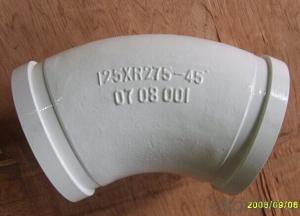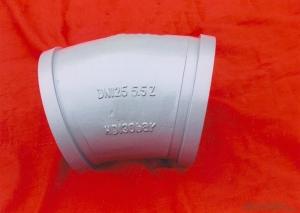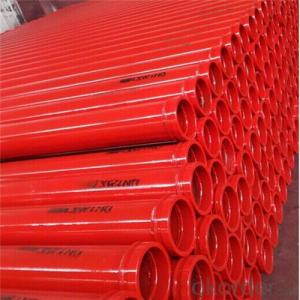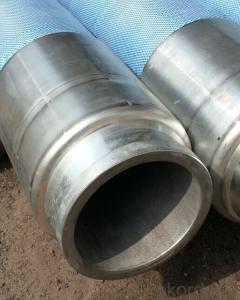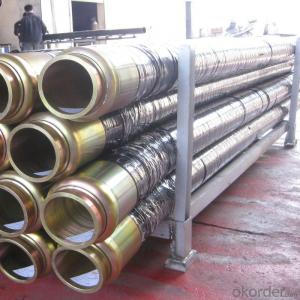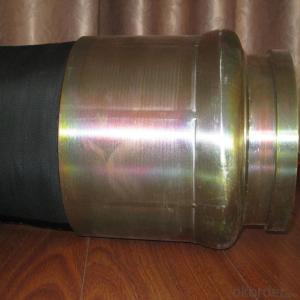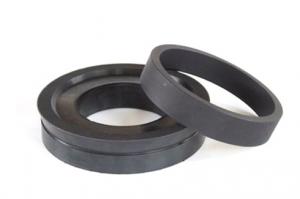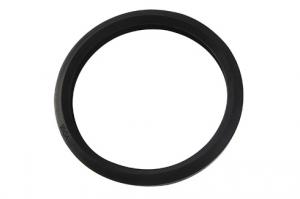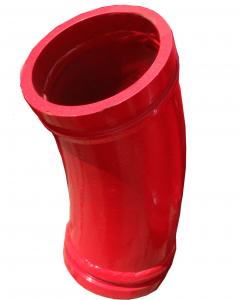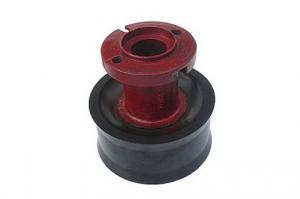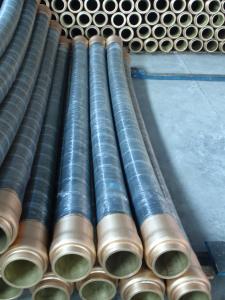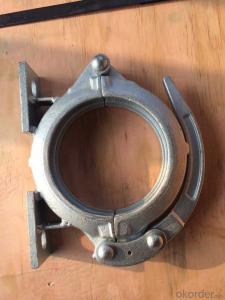Rubber End Hose with Two Side Couplings Working Pressure 85 Bar 3M*DN80
- Loading Port:
- Shanghai
- Payment Terms:
- TT OR LC
- Min Order Qty:
- 10 pc
- Supply Capability:
- 5000 pc/month
OKorder Service Pledge
OKorder Financial Service
You Might Also Like
Product Description:
The 3M*DN80 rubber end hose with two side couplings, normally the hoes is made by NR and reinforced by four layer steel wire, and the two couplings at each side are made by steel material No.ST52, 20#, 37MN5, with hot treatment according to customer’s requests, and also package in bundles or nude packing directly put into container.
Scope of Application of the hose
The 3M*DN80 rubber end hose is a concrete delivery for combined use with other concrete pipelines in concrete placement operations. It can be widely used in the construction of various types of concrete structures like industrial and civil buildings, bridges, roads, and other types of infrastructure.
This end hose can only be used in concrete construction operations, but not in any other operations, like dragging, moving, or hoisting heavy articles or personnel. The end hose is also not allowed to be used in any location where any combustible or explosive material exists or a cave-in may occur.
Product Advantages:
OKorder's 3M*DN180 rubber end hose Channels are durable, strong, and safety. We are the biggest group in this business filed and the majority resources are under our control, which is make sure the delivery time and qualified products, meanwhile we have more than 20 overseas branches our people will go to visit customer very fast for more convenient communication.
Main Product Features:
· Premium quality
· Prompt delivery & seaworthy packing (5-10 days)
Reliable performance
Easy to weld
High safety.
FAQ:
Q1: How soon can we receive the product after purchase?
A1: Within three days of placing an order, we will book the vessel for goods. The specific shipping date is dependent upon international and government factors, but is typically 7 to 30 workdays.
Q2: If we can produce some pipes according to customers request?
A2 Yes, we can produce Concrete Placing Boom according to the difference country situations to make it suitable to the market and customers. We have very professional technical team to make the design.
Q3: How to make a quick resolution for after service?
A35: OKorder and our manufacture both have overseas branches all-around of world, if needed,
Name | Concrete Pump Rubber Hose | |||||
Size | ID | OD | Number of layer | Work pressure | bursting pressure | weight |
3.5" | 113 | 2 | 1200psl | 3000psl | 6.8kg/m | |
4" | 128 | 2 | 1200psl | 3000psl | 7.8kg/m | |
5" | 154 | 2 | 1200psl | 3000psl | 10kg/m | |
5" | 154 | 4 | 1200psl | 3000psl | 12kg/m | |
6" | 181 | 2 | 1200psl | 3000psl | 15kg/m | |
Other size and types upon request | ||||||
Usual Size | 4"-DN80, 5" -DN125, 6"-DN150 | |||||
Material | natrual rubber,steel wire | |||||
Technic | steel wire weaving,composite molding | |||||
Application | used in concrete transport of concrete pump end in construction work | |||||
Serving Brands Of Mounted Truck Concrete Pump And Concrete Pump | SANY,Zoomlion,PM,CIFA and so on | |||||
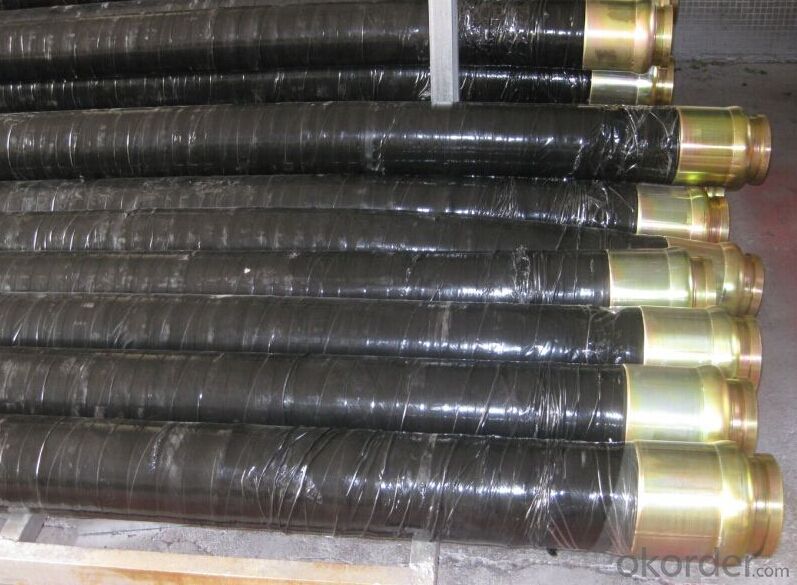
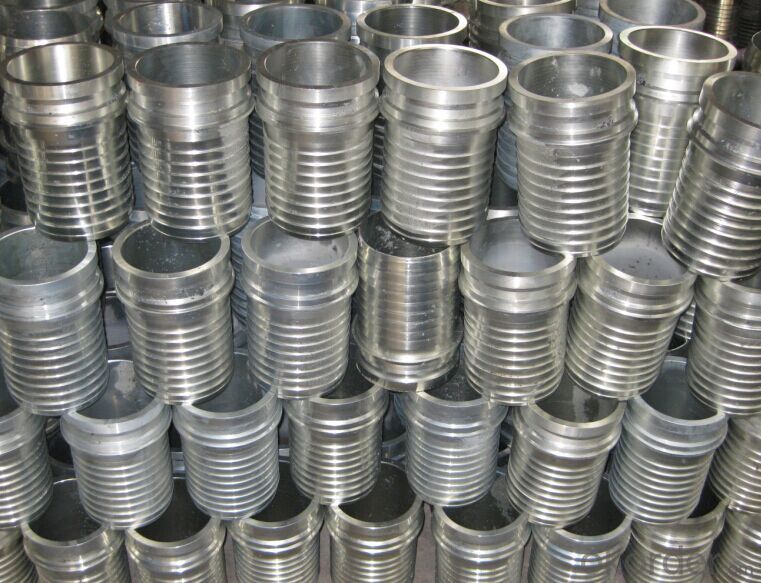
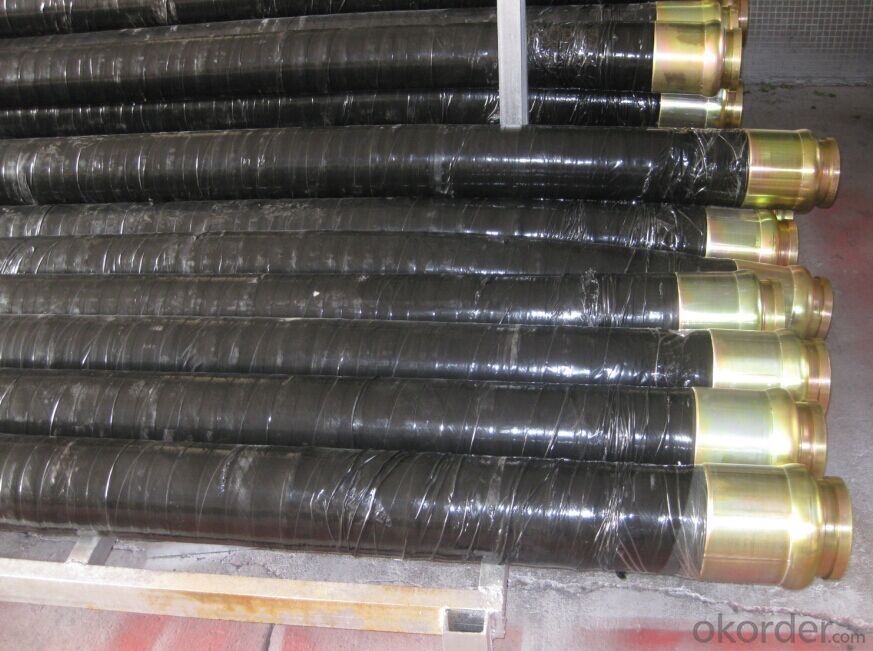
- Q: Are there any maintenance tips to extend the lifespan of concrete pump spare parts?
- Yes, there are several maintenance tips to extend the lifespan of concrete pump spare parts. Regular cleaning and lubrication of the parts, proper storage to prevent corrosion, and routine inspection for wear and tear are essential. Additionally, using high-quality spare parts and following manufacturer's guidelines for maintenance and operation can significantly increase their longevity.
- Q: What is the role of a concrete pump cylinder in a pumping system?
- The role of a concrete pump cylinder in a pumping system is to generate the necessary hydraulic pressure to push the concrete through the pipeline. The cylinder works by converting the mechanical energy from the pump into hydraulic energy, allowing for efficient and controlled movement of the concrete.
- Q: How to operate the concrete pump?
- The size of sand and gravel, cement mark and mixture ratio should meet the requirement of the mechanical performance of the pump according to the specifications of the factory
- Q: How can I extend the lifespan of my concrete pump spare parts?
- To extend the lifespan of your concrete pump spare parts, there are several key steps you can take: 1. Regular maintenance: Implement a comprehensive maintenance schedule for your concrete pump, including the spare parts. This should include regular inspections, cleaning, and lubrication of the parts. By identifying and addressing any issues early on, you can prevent further damage and extend the lifespan of the parts. 2. Use high-quality spare parts: Invest in high-quality spare parts from reputable manufacturers. Cheaper alternatives may save you money initially, but they tend to have shorter lifespans and may require frequent replacements. Opting for quality parts will ensure durability and longevity. 3. Proper storage: Store your spare parts in a clean, dry, and well-organized environment. Exposure to moisture, extreme temperatures, and dirt can deteriorate the parts over time. Consider using protective covers or cases to shield the parts from dust and other contaminants. 4. Train operators: Proper operation of the concrete pump is crucial to preventing unnecessary wear and tear on the spare parts. Ensure that your operators are well-trained and follow the manufacturer's guidelines for usage and maintenance. Discourage any misuse or improper handling of the equipment, as this can lead to premature wear of the spare parts. 5. Regular cleaning: Keep your concrete pump clean by regularly removing any concrete buildup. The accumulation of hardened concrete can cause additional strain on the spare parts and lead to premature failure. Use appropriate cleaning methods and tools to ensure thorough removal without causing damage to the parts. 6. Timely repairs: Address any issues or damage to the spare parts as soon as they are identified. Ignoring or delaying repairs can worsen the problem and potentially cause damage to other components. Regularly inspect the spare parts for signs of wear, such as cracks, leaks, or excessive vibration, and promptly address any concerns. 7. Monitor usage and performance: Keep track of the usage and performance of your concrete pump and spare parts. Regularly monitor the wear and tear of the parts and the overall performance of the pump. Analyze any patterns or trends that may indicate potential problems and take corrective actions to prevent further damage. By following these steps, you can significantly extend the lifespan of your concrete pump spare parts, ensuring optimal performance and reducing the need for frequent replacements.
- Q: How do I properly maintain and replace hydraulic motors in concrete pump spare parts?
- Proper maintenance and replacement of hydraulic motors in concrete pump spare parts involves several key steps. Firstly, it is crucial to regularly inspect and clean the motors to remove any dirt, debris, or build-up that may affect their performance. Additionally, checking and topping up the hydraulic fluid levels is essential to ensure optimal operation. Regularly monitoring the motors for any signs of leaks, unusual noises, or decreased efficiency is also important. If any issues are detected, prompt repairs or replacements should be undertaken by experienced professionals to prevent further damage. It is recommended to follow the manufacturer's guidelines and specifications for maintenance and replacement procedures to ensure the longevity and reliability of the hydraulic motors.
- Q: How do I properly adjust and control flow rates in concrete pump spare parts?
- In order to achieve proper adjustment and control of flow rates in concrete pump spare parts, it is important to follow a series of key steps: 1. Get acquainted with the equipment: Take the time to familiarize yourself with the specific concrete pump spare parts you will be working with. Read the user manual and review any documentation provided by the manufacturer. This will give you a comprehensive understanding of the equipment's capabilities and effective methods for adjusting flow rates. 2. Verify the pump settings: Prior to commencing any concrete pumping operation, ensure that the pump settings are correctly configured. This involves checking the hydraulic pressure, engine RPM, and any other relevant settings. Confirm that all valves and controls are in the appropriate position for the desired flow rate. 3. Monitor the pump speed: The speed of the pump directly influences the flow rate of the concrete. Different concrete mixtures may require varying pump speeds in order to achieve the desired flow rate. Adjust the engine RPM accordingly, referring to the manufacturer's recommendations and any specific project requirements. 4. Modify the pump stroke: Many concrete pumps offer adjustable pump strokes to regulate the flow rate. By altering the length of the stroke, you can increase or decrease the volume of concrete being pumped. Experiment with different stroke lengths to determine the optimum flow rate for your particular application. 5. Utilize the control panel: Numerous concrete pumps are equipped with a control panel that allows for precise adjustment of flow rates. Make use of these features to fine-tune the flow rate. Use the control panel to monitor the pump's performance and make any necessary adjustments to maintain a consistent flow. 6. Regularly inspect and maintain the equipment: Proper maintenance is essential to ensure accurate adjustment and control of flow rates. Routinely inspect the concrete pump spare parts for any signs of wear or damage. Clean and lubricate the components as recommended by the manufacturer. A well-maintained pump will operate more efficiently and provide more precise control over flow rates. By adhering to these steps, one can effectively adjust and control flow rates in concrete pump spare parts. Always prioritize safety and consult the manufacturer's instructions and guidelines for specific recommendations and considerations.
- Q: How can a faulty electric motor affect the pump's performance?
- A faulty electric motor can significantly impact the pump's performance. It may cause the motor to run at a slower speed, leading to reduced pumping capacity and lower flow rates. Additionally, a faulty motor can result in increased power consumption, decreased efficiency, and overheating issues. In severe cases, the motor may completely fail, causing the pump to stop working altogether. Therefore, addressing any issues with the electric motor promptly is crucial to maintaining optimal pump performance.
- Q: Can concrete pump spare parts be ordered in bulk quantities for future use?
- Yes, concrete pump spare parts can definitely be ordered in bulk quantities for future use. Many suppliers and manufacturers offer bulk ordering options to cater to the needs of contractors and construction companies. Ordering in bulk can provide several advantages such as cost savings, convenience, and ensuring a consistent supply of spare parts for maintenance and repairs. It is always recommended to have spare parts readily available to minimize downtime and maximize the efficiency and performance of concrete pumps.
- Q: What is the importance of a concrete pump control valve?
- The operation of a concrete pump heavily relies on the presence of a control valve, which plays a vital role. This crucial component allows for the accurate and efficient management of concrete flow and pressure. To grasp the significance of a concrete pump control valve, one must consider its various functions. Firstly, it serves to regulate the movement of concrete from the hopper to the pumping cylinders. Through manipulation of this valve, operators can adjust the flow rate to meet the specific demands of the project. This ensures that the appropriate amount of concrete is pumped, preventing wastage and optimizing productivity. Secondly, the control valve facilitates precise control of pressure within the pumping cylinders. By making adjustments to the valve, operators can increase or decrease pressure levels, maintaining a consistent and steady concrete flow. This ability is crucial in preventing blockages or clogs within the concrete pump system, which can lead to costly downtime and repairs. Moreover, the control valve enables operators to switch between different pumping modes, such as high-pressure pumping or low-pressure spraying. This versatility allows for the efficient completion of a wide range of concrete pumping tasks, from pouring foundations to applying decorative concrete finishes. In addition to its functional significance, a concrete pump control valve also contributes to the safety of the pumping operation. It empowers operators to halt or reverse the flow of concrete swiftly in the event of emergencies or equipment malfunctions. This feature ensures that potential hazards are promptly addressed, minimizing the risk of accidents and injuries. Overall, the importance of a concrete pump control valve lies in its capacity to provide precise control over concrete flow and pressure during pumping operations. It guarantees efficiency, productivity, versatility, and safety, establishing it as an indispensable component of any concrete pumping system.
- Q: What is the function of a concrete pump remote control antenna?
- The primary role of a concrete pump remote control antenna is to establish a wireless connection between the remote control device and the concrete pump. This connection enables the operator to remotely manage various functions of the concrete pump, including initiating and terminating the pump, adjusting concrete speed and flow, and controlling boom movements. The antenna receives signals transmitted by the remote control device and transmits them to the concrete pump, enabling the operator to safely control the pump from a distance. By providing the operator with improved visibility of the pump and its surroundings, while maintaining complete operational control, this technology contributes to enhanced efficiency, accuracy, and safety at construction sites.
Send your message to us
Rubber End Hose with Two Side Couplings Working Pressure 85 Bar 3M*DN80
- Loading Port:
- Shanghai
- Payment Terms:
- TT OR LC
- Min Order Qty:
- 10 pc
- Supply Capability:
- 5000 pc/month
OKorder Service Pledge
OKorder Financial Service
Similar products
Hot products
Hot Searches
Related keywords
